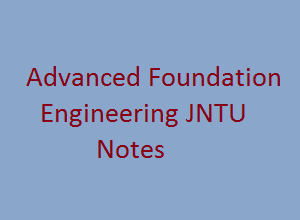Here you can download the free lecture Notes of Advanced Foundation Engineering Pdf Notes (AFE Notes Pdf) materials with multiple file links to download. This Advanced Foundation Engineering Notes Pdf book starts with the topics covering Introduction – Bearing capacity of Footings subjected to Eccentric and inclined loading – Meyerhofi”s, Hansen’s, Vesic theories – Foundations on layered soils, etc.
Download Advanced Foundation Engineering Pdf Notes – AFE notes pdf file

Advanced Foundation Engineering Notes pdf – AFE pdf notes – AFE notes pdf file to download are listed below please check it
Latest Material Links
AFE Complete Notes
1st Unit Notes
2nd Unit Notes
3rd Unit Notes
4th Unit Notes
5th Unit Notes
Advanced Foundation Engineering Notes Pdf (Old Material)
Old Material Link
AFE Complete Notes
Note :- These notes are according to the R09 Syllabus book of JNTU. In R13 and R15, 8-units of R09 syllabus are combined into 5-units in R13 and R15 syllabus. If you have any doubts please refer to the JNTU Syllabus Book.
UNIT I
Introduction-Bearing capacity of Footings subjected to Eccentric and inclined loading – Meyerhofi”s, Hansen’s, Vesic theories – Foundations on layered soils.
UNIT – II
Elastic settlement of Footings embedded in sands and clays of Infinite thickness – Footings on soils of Finite thickness-Schmertamaunn‘s method, janbu method.
UNIT – III
Pile Foundations – static and dynamic methods-pile groups-negative skin friction-under reamed piles.
UNIT -IV
Settlement of Pile groups resting in sands and clays —laterally loaded piles- ultimate capacity of laterally loaded piles.
UNIT – V
Lateral Earth pressures-Rankine – Coloumb’s and graphical methods — stability of cantilever and counter-fort retaining walls, Reinforced earth retaining walls.
UNIT – VI
Cantilever sheet piles and anchored bulkheads, Earth pressure diagram – Determination of Depth of embedment in sands and clays – Timbering of trenches- Earth pressure diagrams – Forces in struts.
UNIT VII
Caissons and well foundations: Types of caissons – well foundations – different shapes of wells – Components of wells – functions and Design – Design Criteria – Sinking of wells — lateral stability by Terzaghi’s analysis.
UNIT VIII
Foundations in Expansive soils — Problems in Expansive soils – Mechanism of swelling-Swell Pressure and Swelling potential-Heave-foundation practices-Sand cushion-CNS technique – under – reamed pile Foundations – Granular pile — anchor technique, stabilization of expansive soils.
Reference:
1 Geo-technical Engineering by C. Venkataramah, New Age International Pvt.Ltd, Publishers (2002).
2 Analysis and Design of Substructures — Swami Saran, Oxford & IBI-I Publishing Company Pvt.Ltd (1998).
3 Basics and Applied Soil Mechanics by Gopal Ranjan & ASR Rao, New Age International Pvt.Ltd, Publishers (2002).
Text books: Advanced Foundation Engineering Books
1 Das, B.M., – ( 1999) Principles of Foundation Engineering -4th edition PWS Publishing, Singapore.
2 Bowles, J.E., (1988) Foundation Analysis and Design – 4th Edition, McGraw-Hill International
3 Geotechnical Engineering: Principles and practices of soil mechanics and foundation Engineering by VNS Murthy, Taylor & Francis Group.
Follow us on Facebook and Support us with your Like
FAQs
Q1: What are the requirements in Foundation design?
A1: When once a site is selected for a particular project, the job of the foundation engineer is to design the foundations for the structures. The following points are needed for this structure:
- A lay out plan of the project
- A plan of load bearing elements such as coulumns, walls, caissons, etc with the estimated dead and live loads
- The strength and settlement characteristics of the subsoil
- The hydraulic conditions of the site
Q2: What is compensated foundation?
A2: A compensated foundation consists of replacing a volume of the ground below the foundations with an equivalent volume of expanded clay (which has a much lower density) thereby reducing the weight and partly or wholly compensating for the loads imposed by the new building.
Q3: What is the bearing capacity of soil?
A3: It is the power of foundation soil to hold the forces from the superstructure without undergoing shear failure or excessive settlement.
Q4: What are well foundations and its types?
A4: Well foundations are one of the types of deep foundations that provide a solid and massive foundation typically for bridges and heavy structures. Well foundations are also useful for transmission line towers, where uplift loads are large. Its types are as follows:
- Open caissons.
2. Box caissons.
3. Pneumatic caissons
Q5: What is raft foundation?
A5: Raft foundation is a thick reinforced concrete slab which spreads over a large area of soil and provides support for several columns and load bearing walls. It is also called as mat foundation which are widely used foundation system.
Q6: What are the different types of raft foundation?
A6:
- Flat Plate Type Raft Foundation
- Thickened Flat plate Type Raft Foundation
- Beam and Slab Type Raft Foundation
- Piled Raft Foundation
- Cellular Raft Foundation
Q7: What is Punching shear?
A7: Punching shear is a type of failure that occurs on slabs due to high localized loads. he dead and live load of the slab will generate a high shear force around the column’s support. If the columns are not well reinforced or the cross-section of columns is not big enough, the punching shear will occur.
